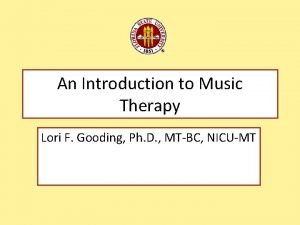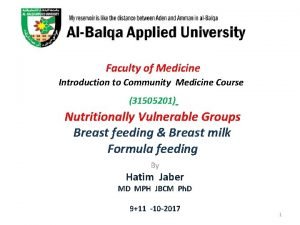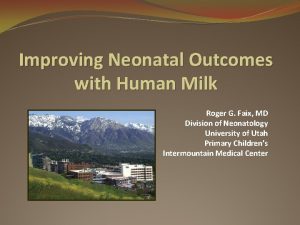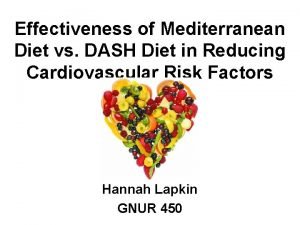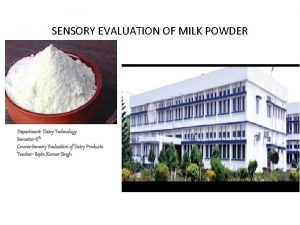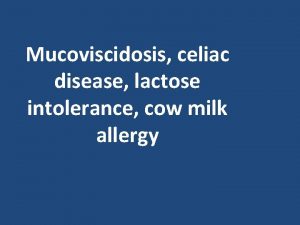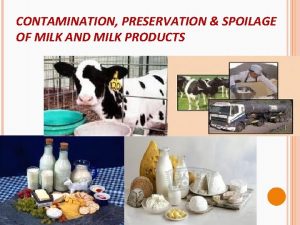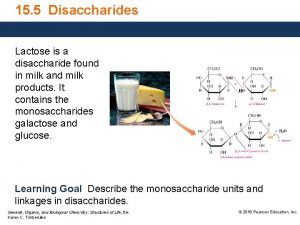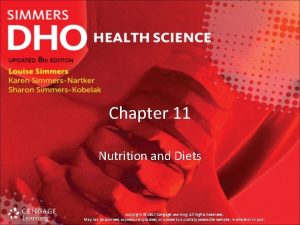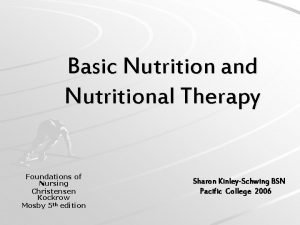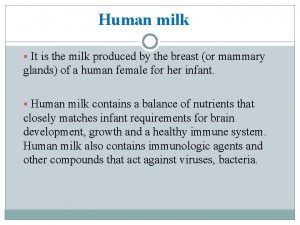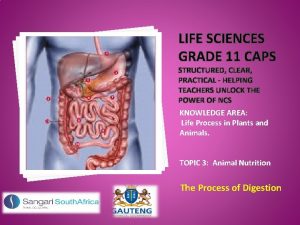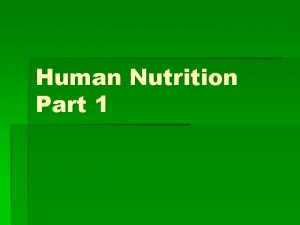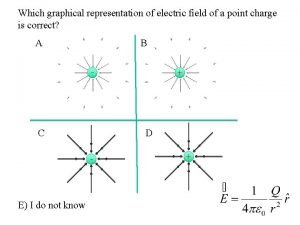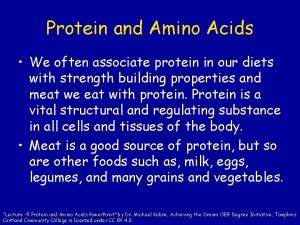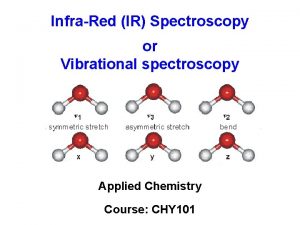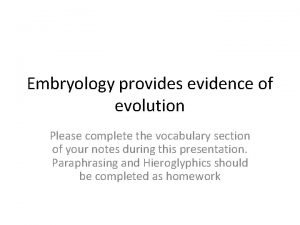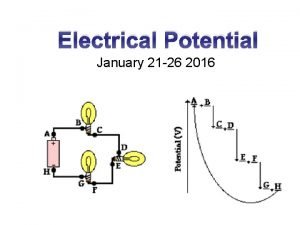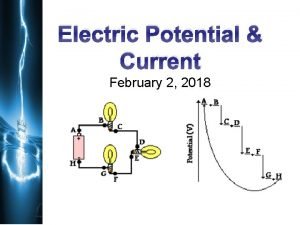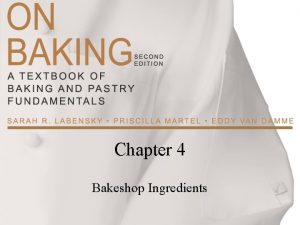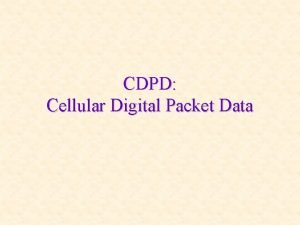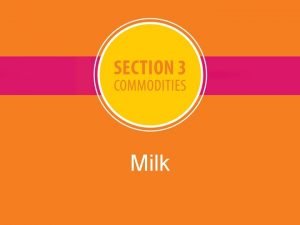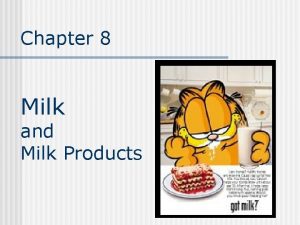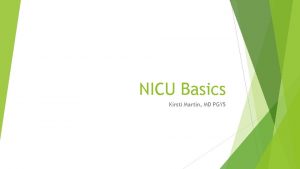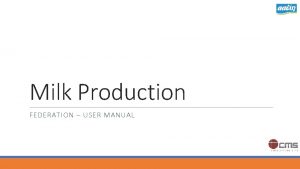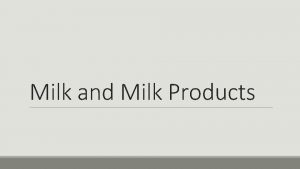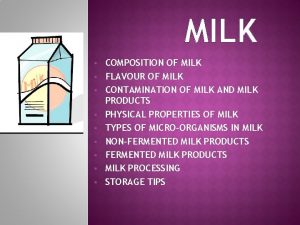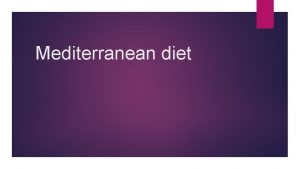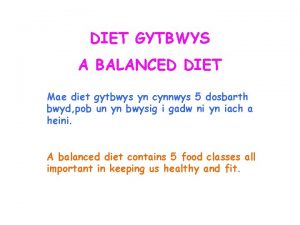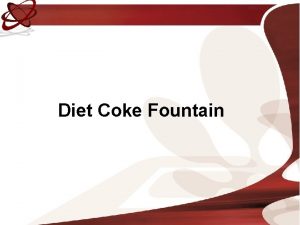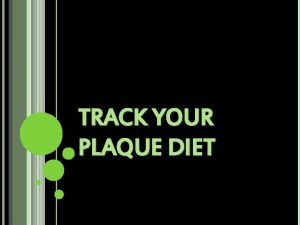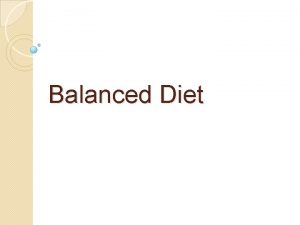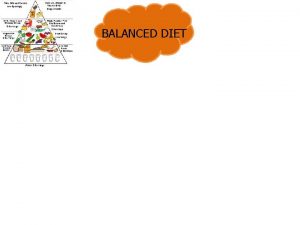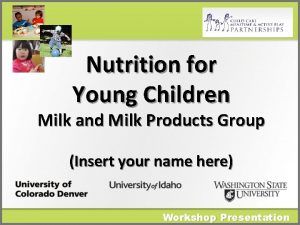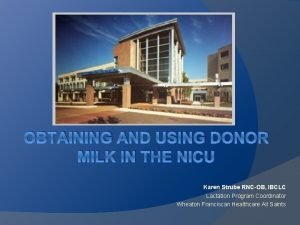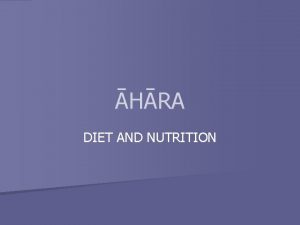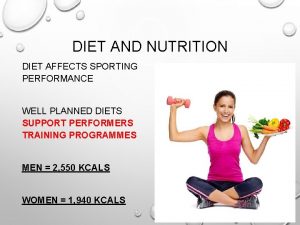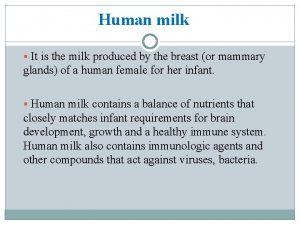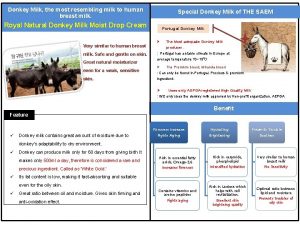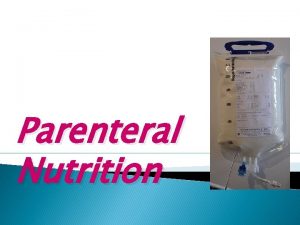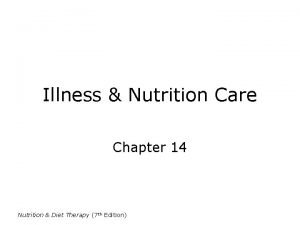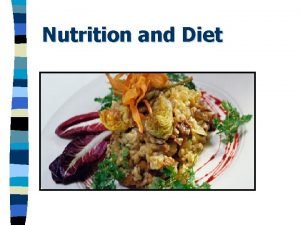Nutrition in the NICU Human Milk Diet Provides







































































- Slides: 71

Nutrition in the NICU: Human Milk Diet Provides Better Tolerance, Growth & Cost Effectiveness A webinar for Health. Trust Members November 5, 2018 Melinda Elliott, M. D. Senior Director, Clinical Education & Professional Development, Prolacta Bioscience Neonatologist, Pediatrix Medical Group of Maryland

Disclosures � I have had no disclosures until August 1, 2016 when I became a Prolacta Employee. I had no support from Prolacta Bioscience, financial or otherwise, at the time of my studies. � This program may contain the mention of drugs or brands presented in a case study or comparative format using evidence-based research. Such examples are intended for educational and informational purposes and should not be perceived as an endorsement of any particular supplier, brand or drug.

Learning Objectives 1. Describe the American Academy of Pediatrics (AAP) and World Health Organization (WHO) recommendations for the use of human milk in preterm infants 2. Recall the published benefits of an Exclusive Human Milk Diet (EHMD) in premature infants 3. Define some long-term outcomes of the EHMD in premature infants

Breast Milk is for Babies, Cows Milk is for Cows* *We need to stop using our “bovine brains!”

Recommendations on the Use of Human Milk in Premature Infants • All preterm infants should receive human milk • Human milk should be fortified for infants weighing <1500 g at birth • The preferred nutrition for the newborn is his/her own mother’s milk (MOM). When this is not available or is limited, pasteurized human donor breast milk (PDHM) is recommended. • PDHM should be prioritized to compromised preterm infants and selected ill term newborns • “The use of donor human milk in appropriate high-risk infants should not be limited by an individual’s ability to pay. Policies are needed to provide high-risk infants access to donor human milk on the basis of documented medical necessity, not financial status. ” Source: AAP Policy Statement. Pediatrics. 2012; 129(3): e 827 -e 841. Pediatrics. 2017; 139(1): e 20163440 Canadian Paediatric Society Position Statement: http: //www. cps. ca/en/documents/position/human-milk-banking WHO Guidelines: http: //www. who. int/maternal_child_adolescent/documents/infant_feeding_low_bw/en/

Why Is Human Milk Critical for Premature Newborns? • Infants with GA ≤ 28 weeks or BW ≤ 1500 grams have very immature GI tracts • Neonatal GI tract must be colonized with “normal” bacteria after birth • Evidence of abnormal bowel colonization ~1 week prior to development of NEC. (Mai PLOS One 2011) § 34% increase of Proteobacteria and § 32% decrease in Firmicutes in NEC cases compared to controls BW = birthweight; GA = gestational age; NEC = necrotizing enterocolitis

Human Milk and the Preterm Infant Microbiome Background: • Establishment of infant microbiome known to be influenced by: § Mode of Birth (Vaginal vs. C-Section) § Antibiotic Administration § Environment of Care § Nutritional Exposures (especially Breastfeeding) • Preterm Infants also influenced by Gestational Age at Birth and Postnatal Age at time of testing • Breastfed full-term infants have “better” bacteria and improved Immune Systems • Preterm Infants commonly have Intestinal Dysbiosis, problematic for short- & long-term health, thought to increase risk of NEC

Influence of Maternal Breast Milk Ingestion on Acquisition of the Intestinal Microbiome in Preterm Infants • Observational Study, 30 Infants, <32 weeks, 199 samples, 1 st 60 Days • 3 Groups: MOM, PDHM (switched to IF at 140 ml/kg/day and >1000 g), IF • MOM: More diverse microbiome early in life § Gradual trajectory toward greater diversity over time • IF: Less diverse § Rapid increase in microbial load over time § May lead to overwhelming inflammatory response (? ? NEC) • PDHM: Similarities to both MOM and IF fed infants § Slower initial colonization, but some of the same bacteria as the IF fed infants. Suggests influence of PDHM on microbiome, but these infants were fed IF at 4 weeks of age Source: Gregory K, et. al. Microbiome. 2016; 4: 68 doi: 10. 1186/s 40168 -016 -0214 -x IF: Infant Formula

Influence of Maternal Breast Milk Ingestion on Acquisition of the Intestinal Microbiome in Preterm Infants, continued • WHY? ? § Presence of many HMOs: Facilitate growth of “good” bacteria § MOM has its own microbiome that actively colonizes the gut § Presence of other bioactive factors in Human Milk (e. g. Secretory Ig. A) that protect against harmful bacteria § Human milk has known host defense properties due to proteins such as lactoferrin, lysozyme, Sec Ig. A, Ig. G, C 3, etc. § MOM also masks the influence of immaturity at birth (this is not seen with IF) • Unknown if EHMD would show same as MOM. No comment on fortification of study infants. Need more research! Source: Gregory K, et. al. Microbiome. 2016; 4: 68 doi: 10. 1186/s 40168 -016 -0214 -x

Preterm Gut Microbiome & Feeding Type �MOM: § Greater Bifidobacteriaceae § Lower Staphylococcaceae, Clostridiaceae & Pasteurellaceae than donor milk BUT �Donor Milk: § Closer microbial profile to MOM than preterm formula Source: Parra-Llorca et. al. Front. Microbiol. 2018

What Is an Exclusive Human Milk Diet (EHMD)? �Diet consisting of 100% Human Milk Derived Products �Mother’s Own Milk (MOM) Preferred �Donor Milk if MOM not available �Only Human Milk Derived Fortifiers (Protein, Fats, Carbohydrates)

Available Human Milk-based Fortifiers �Available in Four Concentrations �Designed to add 4, 6, 8 or 10 calories per ounce to MOM or DM �Caloric Fortifier made from Human Milk Cream also available with 2. 5 cal/ml of product

Benefits of an Exclusive Human Milk Diet

Initial Outcomes Centered Around NEC & PN �EHMD had lower rate of NEC than diet of MOM/Donor Milk and Bovine fortifier (Sullivan S. J Pediatr, 2010). �EHMD (Donor Milk/Human Milk Based Fortifiers) had lower PN days and lower NEC (Cristafalo E. J Pediatr, 2013) �EHMD Reduced probability of remaining on PN (Ghandehari H. BMC Research Notes 2012) EHMD= Exclusive Human Milk Diet; PN= Parenteral Nutrition

The Exclusive Human Milk Diet and NEC Combined Clinical Trial Data Analysis-Results 17% 5% p=0. 002 100% Human Milk 12% 1% p=0. 0003 Any Cow Milk. Based Nutrition Incidence of NEC 100% Human Milk Any Cow Milk. Based Nutrition Incidence of Surgical NEC “An exclusive human milk diet, devoid of cow milk containing products, was associated with lower mortality and morbidity in extremely preterm infants without compromising growth and should be considered as an approach to nutritional care of these infants. ” Source: Abrams S, et al. Breastfeed Med. 2014; 9: 29 -37. doi: 10. 1089/bfm. 2014. 0024.

Other Benefits Beyond NEC

Greater Mortality & Morbidity in Extremely Preterm Infants Fed a Diet Containing Cow Milk Protein Products EHMD had lower Mortality, NEC, Surgical NEC, Sepsis “For each 10% increase in the intake of other than an EHMD, the risk of NEC increases by 11. 8%, and the risk of surgical NEC increases by 21%. . For each 10% increase in the intake of other than an EHMD, there was a 17. 9% increase in risk of sepsis. ” Source: Abrams SA, et. Al. Breastfeeding Medicine 2014: 9; 0: 1 -5

More Human Milk = More Chance of Remaining NEC Free, Combined Clinical Trial Data Analysis Probability of Remaining NEC Free vs. % Cow Milk-Based Diet 1. 00 P (remaining NEC Free) 0. 90 0. 80 0. 70 0. 60 0. 50 0 4 8 12 16 20 24 28 32 36 40 44 48 52 56 60 64 68 72 76 80 84 88 92 96 100 Percent (%) Total Diet from Cow Milk-Based Source: Abrams S, et al. Breastfeed Med. 2014; 9: 29 -37. doi: 10. 1089/bfm. 2014. 0024.

More Human Milk = More Chance of Remaining Sepsis Free, Combined Clinical Trial Data Analysis Probability of Remaining Sepsis Free vs. % Cow Milk-Based Diet Source: Abrams S, et al. Breastfeed Med. 2014; 9: 29 -37. doi: 10. 1089/bfm. 2014. 0024.

Beyond NEC Beyond Necrotizing Enterocolitis Prevention: Improving Outcomes with an Exclusive Human Milk-based Diet � 1587 Infants <1250 g � 4 Centers in 4 states �Retrospective cohort study �EHMD had Significantly Lower: § NEC § Mortality § Late Onset Sepsis § ROP § BPD Source: Hair AB, et. al. Breastfeeding Medicine 2016; 11(2): 1 -5.

Beyond NEC Source: Hair AB, et. al. Breastfeeding Medicine 2016; 11(2): 1 -5.

Exclusive Human Milk Diet & ROP • Small Randomized Trial in Canada (127 Infants) • Avg. 27 weeks, 890 g • Reduction in Severe ROP from 10. 7% in Bovine fortifier group to 1. 6% in EHMD group (p = 0. 04) • Late Onset Sepsis 23% in Bov vs 12. 5% in EHM but study too small for significance Source: O’Connor D. Am J Clin Nutr. 2018; 9: 1 -9.


Herman & Walter Samuelson Children’s Hospital at Sinai • Level 3+ NICU • Community teaching hospital with pediatric residents, but no fellows • Incidence on NEC well within VON incidence • Length of Stay at lower end of VON • Stable neonatology attending staff • Dedicated NICU Lactation Consultant • Did not have Donor milk or Human milk-based fortifier at start of study • Made decision to use EHMD

Why Adopt EHMD? • AAP recommendations on the use of Human Milk in Premature Infants • NEC rate within VON rate, but on high end (babies <1250 g) • Extreme LOS for some babies, but overall on low end of VON • Horrific case of uncomplicated 27 -week infant with NEC, subsequent short bowel syndrome & eventual death at 8 months of age from sepsis and liver failure • Human/Family costs

Study Design • EHMD qualifying criteria: BW < 1250 grams or <29 weeks (Babies at high risk of NEC and extreme LOS) • Breast Milk Feeds started at ~10 -20 ml/kg/day on day 1 -2 • Bolus feeds, not continuous (due to fat loss in tubing) • EHMD started March 1, 2012 • Donor milk used if mother cannot or will not express milk • Human Milk Based fortifier started at 120 ml/kg/day feeds (keeping feeding protocol consistent throughout study period) • Nurses mix milk and fortifier in milk room (one bottle at a time, not entire 24 hr. period) Maryland is a tissue license state, so BDRs and individual milk bottle log in required • Babies given Donor milk (as needed) and Human Milk Based fortifier until 34 weeks gestational age, then weaned gradually over 4 days

Study Design (continued) Groups Group H: Exclusive human milk (Mother’s or Donor) Group B: Mother’s milk + bovine-based fortifier Group M: Combination mother’s milk, bovine-based fortifier, and formula Group F: Formula only

Definitions • Time to full feeds: Time from birth until receiving 150 m. L/kg/day feeds • Feeding intolerance: Feeds interrupted and held for greater than 24 hours

Results N=293 Human Bovine Mixed Formula Total 87(30%) 127 (43%) 49 (17%) 30 (10%) ROP 11 (14%) 40 (32%) 19 (40%) 4 (14%) <0. 001 Sepsis 1 (1. 2%) 3 (2. 3%) 3 (6. 1%) 0 (0%) 0. 545 BPD 13 (15%) 30 (24%) 21 (42%) 3 (10%) <0. 001 GA wks (+/-SD) 27. 7(± 2. 7) 28. 3(± 2. 8) 27. 6(± 2. 8) 29. 8(± 2. 5) <0. 002 Growth Velocity g/kg/d (+/-SD) 11. 6(± 2. 7) 11. 6 (± 2. 5) 11. 2(± 3. 0) 12. 1(± 3. 2) 0. 377

Feeding Intolerance: Number of Times Feeds Held for >24 Hrs 0 1 2+ 6% Fisher’s exact test P=0. 0001 7% 17% 29% 17% 27% 35% 94% 66% 37% H B Groups M F

Additional Days to Full Feeds 12 10 9. 25 10. 27 9. 39 P=0. 0001 8 6 4 2 0 0 Bovine Mixed Formula Human (control)

Additional Days of Hospitalization 25 20 22. 9 P=0. 01 15 10 5 0 7. 26 4. 5 P=0. 374 Bovine 0 Mixed Formula Human (Control)

Incidence of Necrotizing Enterocolitis (<1250 g) 12. 00% 10. 00% 8. 00% 6. 00% 4. 00% 2. 00% 0. 00% Bovine and Mixed Human

Additional Hospital Cost (283 Infants) $120, 000. 00 P=0. 004 $100, 000. 00 $106, 968 P= 0. 004 $80, 000. 00 $60, 000. 00 $40, 000. 00 $29, 178 $27, 387 P=0. 175 P=0. 309 $0. 00 Bovine Mixed Formula $0 Human (control) Human group includes cost of donor milk and fortifier products

Additional Physician Charges (293 Infants) Bovine + Mixed, $25, 765 $30, 000 Formula, $14, 490 P=0. 001 $25, 000 $20, 000 Cost in dollars P=0. 103 $15, 000 $10, 000 Human (control) $5, 000 $0 Human group includes cost of donor milk and fortifier products

Additional Decreased Cost & Improved Feeding Tolerance in VLBW Infants Fed an Exclusive Human Milk Diet (EHMD): A Reanalysis of the Data Maushumi Assad, MD, MPH, Joseph H. Abraham, Sc. D, & Melinda J. Elliott, MD, FAAP Herman and Walter Samuelson Children’s Hospital at Sinai Baltimore, MD Source: INAC Platform Presentation. Lyon, France. July 2017.

Increased Time to Full Feeds (Adjusted for Gestational Age) 5 Days 4 3 2 1 p<0. 007 p=0 Bovine Mixed p<0. 004 0 Study Group Formula Human

Total Cost Difference After Paying for EHMD Products 40000 U. S. Dollars 30000 20000 P=0. 031 10000 0 -10000 P=0. 496 NS P=0. 850 NS -20000 Study Group Bovine Mixed Formula

Remember Feeding Intolerance? (Number of Times Feeds Held for >24 Hrs) 0 1 2+ 6% Fisher’s exact test P=0. 0001 7% 17% 29% 17% 27% 35% 94% 66% 37% H B M Groups F

Increased Cost Due to Feeding Intolerance (per patient, adjusted for gestational age, excluding NEC) $ 35, 000. 00 $ 30, 000. 00 $ 25, 000. 00 $29, 661 U. S. Dollars P=0. 023 $ 20, 000. 00 $ 15, 000. 00 $ 10, 000. 00 $ 5, 000. 00 $- Feeds Held > 24 hours Feeds Not Held

Growth Is Important!

Feeding Guidelines Early enteral feedings and Standardized approach to feeding • Improve Intestinal Motility • Stimulate Intestinal Hormonal Response • Improve Feeding Tolerance • Promote earlier achievement of full feeds • Decrease problems related to prolonged TPN Babies can safely be fed more rapidly with the EHMD!

Human Milk Feeding Supports Adequate Growth in Infants ≤ 1250 Grams Birth Weight • Prospective Observational Study, Single Center • Mean BW 913 g, Mean GA 27. 6 weeks • Feeds started within 24 hours of birth at 20 ml/kg/day MOM or DM • Fortify to +4 at 60 ml/kg/day, +6 at 80 -100 ml/kg/day, +8 if weight gain <15 g/kg/day, Wean at 34 weeks Source: Hair AB, et. al. BMC Research Notes ; 2013(6): 459

Human Milk Feeding Supports Adequate Growth in Infants ≤ 1250 Grams Birth Weight • Lower Rate Extrauterine Growth Restriction (22%, excluding those SGA at birth) • Mean 8. 4 days to regain birthweight • Mean Weight Gain of 25 g/kg/day Improved over Bovine or Later fortification • Mean Length gain 0. 99 cm/wk (Same as Bovine or Later fortification) • Mean HC gain 0. 72 cm/wk • SGA babies had same growth velocity as AGA babies, but remained SGA Source: Hair AB, et. al. BMC Research Notes ; 2013(6): 459


Premature Infants 750– 1, 250 g Birth Weight Supplemented With a Novel Human Milk-Derived Cream are Discharged Sooner Prospective, Randomized Trial 27. 7 weeks, BW 973 +/- 145 grams Standardized EHMD Feeding Protocol Both Groups Cream Group received Human Milk Caloric Fortifier if MOM/DM <20 cal/oz • Cream Group had Lower Post-Menstrual Age at Discharge and Shorter LOS • Babies with BPD Seemed to do even Better • BPD Cream Study ongoing now • • Source: Hair A, et al. Breastfeeding Medicine. 2016: 11(3)DOI: 10. 1089/bfm. 2015. 0166

Texas Children’s Hospital— Sample Feeding Protocol: 751 -1250 g

Growth at Sinai: Initial Study • Study had unchanged growth, but we did not change our feeding protocol (we still were using our bovine brains)! • Mean weight gain 19 g/day • Mean weight gain velocity 12 g/kg/day, no different from bovine, but not good enough in 2016!

Sinai Revised Feeding Protocol Infants < 1250 grams or <29 weeks: • Start feeds within 24 -48 hours • Advance feeds daily by 10 -20 ml/kg/day • Fortify with Human Milk Based Fortifier +6 when feeds reach 60 ml/kg/day feeds • Feeding volume goal 160 ml/kg/day, unless medically contraindicated • Add Human Milk Caloric Fortifier when at 100 ml/kg/day fortified feeds if using only HMBANA donor milk (no MOM) • Add Human Milk Caloric Fortifier if, after 3 days full volume fortified feeds, weight gain less than optimal; Increase as needed

Effects of a Standardized Feeding Protocol on Weight Gain in Very Low Birth Weight Infants • Adopted more appropriate standardized feeding protocol with EHMD to improve growth • Average weight gain in this population 23 g/day • Average head circumference increase: 0. 86 cm/wk • Average length increase: 0. 97 cm/wk Source: Swerdfeger, Elliott. Presented at Region 4 Academic Pediatric Association Conf. 2017. Charlottesville, VA

Incidence & Timing of Presentation of Necrotizing Enterocolitis in Preterm Infants NEC presents at mean age of 7 days in more mature infants. NEC delayed to 32 days of age in smaller, lower GA infants. Distribution of cases of NEC according to GA and postmenstrual age (PMA) in the study cohort. Source: Yee, et. al. Pediatrics. 2012

Improving Growth for Infants 1250 Grams Receiving an Exclusive Human Milk Diet Legacy Randall Children’s Hospital Table 4. Growth and Clinical Data for Donor Human Milk Era 2/Bov Fortifier (Mean ± SD or Proportion) (Formal Protocol) Table 5. Growth and Clinical Data for Exclusive Human Milk Era 2 (Mean ± SD or Proportion) (+4 at 40 ml/kg/day feeds) EHM 2 HMBF 2 N 111 N 94 PMA, weeks 27. 1 ± 2. 0 PMA, weeks 26. 6 ± 2. 4 Birth weight, g 959 ± 174 Birth weight, g 904 ± 200 Weight gain, g/kg/d 14. 1 ± 1. 8 Weight gain, g/kg/d 13. 6 ± 1. 6 Length gain, cm/wk 1. 03 ± 0. 23 Length gain, cm/wk 1. 06 ± 0. 19 Head circ gain, cm/wk 0. 79 ± 0. 18 Head circ gain, cm/wk 0. 81 ± 0. 15 Source: Huston RK, et. al. Nutrition in Clinical Practice; DOI: 10. 1002/ncp. 10054. 2018.

Optimizing Nutrition: Mother’s Own Milk (MOM) Support Mother’s Own Milk �Education of Family: § Milk is Medicine § Risks of Not Receiving Human Milk § Dedicated NICU Lactation Consultant with flexible schedule

Optimizing Nutrition: MOM � Establish and Maintain Supply § § § § Frequent skin-to-skin contact Pumping at bedside Early post-delivery expression (Teach breast massage and hand expression) Early feeding (first hours to day) and mouth care with colostrum Provide pumping log/diary/App (Peek. ABoo ICU or other app) Inquire at regular intervals “How is pumping going? ” Track Maternal Supply to intervene if noted to be decreasing Non-nutritive Breastfeeding

Peekaboo ICU

Optimizing Nutrition: Protein Content Product Protein/100 ml Protein/150 ml mixed with Preterm Milk** Term Milk** H 2 MF+4 2. 3 2. 1 3. 5 3. 2 H 2 MF+6 2. 8 2. 6 4. 2 3. 9 H 2 MF+8 3. 2 3. 1 4. 8 4. 6 H 2 MF+10 3. 7 3. 6 XXXX **Preterm Milk Assumes Protein of 1. 4 g/100 ml **Term Milk Assumes Protein of 1. 1 g/100 ml If protein load well over 4 g/kg/day, Renal injury is possible and growth may be poor.

Optimizing Nutrition �Bolus feeds best over slow pump flow rates or continuous feeds § Increased fat loss with tubing (Kangaroo pump worse than syringe pump) § H 2 MF and/or Cream improve fat delivery even with continuous feeds �Cream shown to shorten Length of Stay in 750 -1250 g infants (not specifically studied yet in <750 g group) �Substantial Calcium and Phosphorus losses with continuous feeds, minimized in vitro with Human milk based fortification (no direct Ca. Phos salt loss as in bovine fortified milk) �Estimated calorie loss ranged between 3 kcal/kg/day to 25 kcal/kg/day depending on fortifier and feeding method

Fortifier & Cream Improve Fat Delivery in Continuous Enteral Infant Feeding of Breast Milk Source: Tabata, et. al. 2015

Optimizing Nutrition � Length of Feeding Tubing? § The longer the tubing, the more human milk fat that get stuck to it. If the calories are getting stuck in the tubing, the baby isn't getting them in his/her feeding. � The syringe position (when the feeding is given via a pump)? § Fat is a necessary nutrient. Fat rises to the top which means that the syringe tip facing up, will allow for maximal fat to be delivered to the patient. � Are the feeds bolus or continuous? § Continuous feeds allow for more fat sticking to the tubing and less fat getting to the baby. � How often are feeding tubes changed? § Frequently, new tubes will give a greater new surface area for the fat to stick to which leads to loss of nutrition. All can contribute to poor weight gain!

Long-term Benefits

Breast Milk Consumption in Preterm Neonates & Cardiac Shape in Adulthood • 30 former preterm (gestational age ~30 weeks) infants born 1982 -85. Now 23 -28 years old. • 30 EHMD, 16 Formula • Compared with Term Controls • Cardiac Morphology & Function assessed by MRI Source: Lewandowski AJ, Lamata P, Francis JM, et al. Breast Milk Consumption Preterm Neonates and Cardiac Shape in Adulthood. Pediatrics. 2016; 138(1): e 20160050

Breast Milk Consumption in Preterm Neonates & Cardiac Shape in Adulthood Source: Lewandowski, AJ, Lamata P, Francis JM, et al. Breast Milk Consumption Preterm Neonates and Cardiac Shape in Adulthood. Pedoatrics. 2016; 138(1): e 20160050

Breast Milk Consumption in Preterm Neonates & Cardiac Shape in Adulthood • EHMD fed patients had increased Left and Right Ventricular end -diastolic volume index and stroke volume index compared with preterm-born individuals who were exclusively formula fed as infants • Both smaller than term controls, but EHMD group reduction only 9% compared to 18% for Formula fed group Source: Lewandowski, AJ, Lamata P, Francis JM, et al. Breast Milk Consumption Preterm Neonates and Cardiac Shape in Adulthood. Pedoatrics. 2016; 138(1): e 20160050

5 -year Outcomes of an Exclusive Human Milk Diet: Growth, Body Composition & Neurodevelopment Source: Bergner, et. al. PAS Poster Presentation. Toronto, ON, CA. 2018

5 -year Outcomes of an Exclusive Human Milk Diet: Growth Weight Source: Bergner, et. al. PAS Poster Presentation. Toronto, ON, CA. 2018 Length

5 -year Outcomes of an Exclusive Human Milk Diet: Body Composition Exclusive HM Matched Term Cohort Controls (n=31) p-value Age (y) 5. 3 ± 0. 2* 5. 3 ± 0. 8 0. 904 Weight (kg) 17. 4 ± 2. 4 17. 5 ± 2. 0 0. 835 Height (cm) 108. 9 ± 5. 5 108. 7 ± 5. 5 0. 832 Bone Mineral Content (g) 659. 7 ± 87. 6 646. 7 ± 72. 8 0. 448 Bone Mineral Density (g/cm 2) 0. 63 ± 0. 05 0. 62 ± 0. 05 0. 736 Fat Mass (kg) 4. 25 ± 1. 16 4. 25 ± 0. 89 0. 998 Fat Mass Index (kg/m 2) 4. 14 ± 1. 39 4. 23 ± 0. 765 % Fat 24. 0 ± 4. 7 23. 7 ± 4. 6 0. 801 Lean Mass (kg) 12. 78 ± 1. 78 13. 05 ± 1. 75 0. 402 Lean Mass Index (kg/m 2) 10. 69 ± 2. 62 10. 94 ± 0. 80 0. 581 Android : Gynoid Ratio 0. 55 ± 0. 09 0. 55 ± 0. 10 0. 826 Trunk : Leg % Fat Ratio 0. 64 ± 0. 06 0. 64 ± 0. 08 0. 883 Trunk : Limb Fat Ratio 0. 73 ± 0. 11 0. 67 ± 0. 09 0. 025 Appendicular Fat Free Mass (kg/m 2) 3. 89 ± 1. 00 4. 15 ± 0. 49 0. 156 Source: Bergner, et. al. PAS Poster Presentation. Toronto, ON, CA. 2018

5 -year Outcomes of an Exclusive Human Milk Diet: Neurodevelopment Exclusive HM Composite Index Score (n=31) Standard Score Range of the Mean Composite Index Score <70† n (%) Verbal Comprehension 95 ± 25* Average 3 (10) Visual Spatial 95 ± 40 Average 1 (3) Fluid Reasoning 97 ± 46 Average 3 (10) Working Memory 94 ± 38 Average 1 (3) Processing Speed 94 ± 41 Average 3 (10) Full Scale Intelligence Quotient (IQ) 93 ± 38 Average 3 (10) Source: Bergner, et. al. PAS Poster Presentation. Toronto, ON, CA. 2018

Important to Remember: • Provide good lactation support to Mom • Develop a Protocol and try to stick to it as a group • Administration will want to see outcomes, so keep your data • Feed & fortify early for best growth • Ensure adequate protein intake (~4 g/kg/day, Concentrate protein in PN as you wean volume) • Bolus feed as possible for best growth


References � Bergner, et. al. 5 Year Outcomes of an Exclusive Human Milk Diet: Growth, Body Composition, and Neurodevelopment. PAS Poster Presentation. Toronto, ON, CA. 2018 � Bisquera JA, Cooper TR, Berseth CL. Impact of necrotizing enterocolitis on length of stay and hospital charges in very low birth weight infants. Pediatrics. 2002; 109: 423 -42. � Sullivan S, et. al. An Exclusive Human Milk-Based Diet IS Associated with a Lower Rate of Necrotizing Enterocolitis that a Diet of Human Milk and Bovine Milk-Based Products. J Pediatr. 2010; 156: 562 -7. � Rogers SP, et. al. Continuous Feedings of Fortified Human Milk Lead to Nutrient Losses of Fat, Calcium and Phosphorous. Nutrients. 2010: 2: 230 -240. � Viadyanathan G, Hay JW, Kim JH. Cost of necrotizing enterocolitis and cost-effectiveness of exclusively human milk based products in feeding extremely premature infants. Breastfeed Med. 2011; 6: 1 -9. � Neu J, Walker AW. Necrotizing Enterocolitis. N Engl J Med. 2011; 364: 255 -64. � Ganapathy V, et. al. Costs of Necrotizing Enterocolitis and Cost-Effectiveness of Exclusively Human Milk-Based Products in Feeding Extremely Premature Infants. Breastfeeding Med. 2012; 7: 29 -37. � Breastfeeding and the Use of Human Milk. AAP Policy Statement. Pediatrics. 2012; 129(3): e 827 -e 841. � Bhatia, J. Human milk and the premature infant. Ann Nutr Metab. 2013; 62 (suppl. 3): 8 -14. � Cristofalo EA, et. al. Randomized Trial of Exclusive Human Milk versus Preterm Formula Diets in Extremely Premature Infants. J Pediatr. 2013; 163: 1592 -5. � Hair AB, et. al. Human milk feeding supports adequate growth in infants ≤ 1250 grams birth weight. BMC Research Notes. 2013; 6: 459 � Meredith-Dennis L, et. al. Composition and Variation of Macronutrients, Immune Proteins, and Human Milk Oligosaccharides in Human Milk From Nonprofit and Commercial Milk Banks. J Hum Lact. 2017; DOI: 10. 1177/0890334417710635.

References � Parra-Llorca, et. al. Preterm Gut Microbiome Depending on Feeding : Significance of Donor Human Milk. Front. Microbiol. 2018; DOI: 10. 3389/fmicb. 2018. -1376. � Patel AL, et. Al. Impact of Early Human Milk on Sepsis and Health-Care Costs in Very Low Birth Weight Infants. J Pernatol. 2013; 33: 514 -519. � National Center for Health Statistics. March of Dimes Peristatistics, 2013. http: //www. marchofdimes. com/Peristats/pdflib/195/99. pdf. Accessed September 29, 2014. � Abrams SA, et. Al. Greater Mortality and Morbidity in Extremely Preterm Infants Fed a Diet containing Cow Milk Protein Products. Breastfeeding Medicine. 2014; 9: 1 -5 � Huston RK, et. al. Decreasing Necrotizing Enterocolitis and Gastrointestinal Bleeding in the Neonatal Intensive Care Unit The Role of Donor Human Milk and Exclusive Human Milk Diets in Infants <1500 g Birth Weight. ICAN: Infant, Child, & Adolescent Nutrition. 2014; 6(2): 86 -93. � Zhou J, et. Al. Human Milk Feeding as a Protective Factor for Retinopathy of Prematurity: A Meta-analysis. Pediatrics. 2015; 136(6): e 1576 e 1586. � Tabata M, et. al. Fortifier and Cream Improve Fat Delivery in Continuous Enteral Infant Feeding of Breast Milk. Nutrients. 2015; 7: 11741183. � Assad M, Elliott MJ, Abraham JH. Decreased Cost and Improved Feeding Tolerance in VLBW Infants Fed an Exclusive Human Milk Diet. J Perinatol. 2016; 36: 216 -220. � Hair AB, et. al. Premature Infants 750– 1, 250 g Birth Weight Supplemented with a Novel Human Milk-Derived Cream Are Discharged Sooner. Breastfeeding Medicine. 2016; 11(3): 133 -137. � Hair AB, et. al. Beyond Necrotizing Enterocolitis Prevention: Improving Outcomes with an Exclusive Human Milk-Based Diet. Breastfeed Med. 2016: 11(2): 1 -5. � Lewandowski AJ, et al. Breast Milk Consumption in Preterm Neonates and Cardiac Shape in Adulthood. Pediatrics. 2016; 138(1): e 20160050.
 Socrates pain
Socrates pain Lori gooding
Lori gooding Human milk vs cow milk
Human milk vs cow milk Human milk vs cow milk
Human milk vs cow milk Dash diet vs mediterranean
Dash diet vs mediterranean Milk diet results
Milk diet results Sensory evaluation of milk and milk products
Sensory evaluation of milk and milk products Milk for toddlers with milk allergynon dairy
Milk for toddlers with milk allergynon dairy Contamination of milk and milk products
Contamination of milk and milk products Lactose disaccharide
Lactose disaccharide Chapter 11 nutrition and diet
Chapter 11 nutrition and diet Chapter 11 nutrition and diets
Chapter 11 nutrition and diets Nutrition and diet therapy nursing
Nutrition and diet therapy nursing Casein in human milk
Casein in human milk Human nutrition grade 11
Human nutrition grade 11 Stages of human nutrition
Stages of human nutrition Eli weaver human services
Eli weaver human services Hát kết hợp bộ gõ cơ thể
Hát kết hợp bộ gõ cơ thể Ng-html
Ng-html Bổ thể
Bổ thể Tỉ lệ cơ thể trẻ em
Tỉ lệ cơ thể trẻ em Voi kéo gỗ như thế nào
Voi kéo gỗ như thế nào Chụp phim tư thế worms-breton
Chụp phim tư thế worms-breton Hát lên người ơi
Hát lên người ơi Các môn thể thao bắt đầu bằng từ đua
Các môn thể thao bắt đầu bằng từ đua Thế nào là hệ số cao nhất
Thế nào là hệ số cao nhất Các châu lục và đại dương trên thế giới
Các châu lục và đại dương trên thế giới Công thức tính độ biến thiên đông lượng
Công thức tính độ biến thiên đông lượng Trời xanh đây là của chúng ta thể thơ
Trời xanh đây là của chúng ta thể thơ Mật thư anh em như thể tay chân
Mật thư anh em như thể tay chân 101012 bằng
101012 bằng độ dài liên kết
độ dài liên kết Các châu lục và đại dương trên thế giới
Các châu lục và đại dương trên thế giới Thơ thất ngôn tứ tuyệt đường luật
Thơ thất ngôn tứ tuyệt đường luật Quá trình desamine hóa có thể tạo ra
Quá trình desamine hóa có thể tạo ra Một số thể thơ truyền thống
Một số thể thơ truyền thống Cái miệng xinh xinh thế chỉ nói điều hay thôi
Cái miệng xinh xinh thế chỉ nói điều hay thôi Vẽ hình chiếu vuông góc của vật thể sau
Vẽ hình chiếu vuông góc của vật thể sau Nguyên nhân của sự mỏi cơ sinh 8
Nguyên nhân của sự mỏi cơ sinh 8 đặc điểm cơ thể của người tối cổ
đặc điểm cơ thể của người tối cổ V cc cc
V cc cc Vẽ hình chiếu đứng bằng cạnh của vật thể
Vẽ hình chiếu đứng bằng cạnh của vật thể Tia chieu sa te
Tia chieu sa te Thẻ vin
Thẻ vin đại từ thay thế
đại từ thay thế điện thế nghỉ
điện thế nghỉ Tư thế ngồi viết
Tư thế ngồi viết Diễn thế sinh thái là
Diễn thế sinh thái là Dạng đột biến một nhiễm là
Dạng đột biến một nhiễm là Thế nào là số nguyên tố
Thế nào là số nguyên tố Tư thế ngồi viết
Tư thế ngồi viết Lời thề hippocrates
Lời thề hippocrates Thiếu nhi thế giới liên hoan
Thiếu nhi thế giới liên hoan ưu thế lai là gì
ưu thế lai là gì Hổ đẻ mỗi lứa mấy con
Hổ đẻ mỗi lứa mấy con Sự nuôi và dạy con của hổ
Sự nuôi và dạy con của hổ Hệ hô hấp
Hệ hô hấp Từ ngữ thể hiện lòng nhân hậu
Từ ngữ thể hiện lòng nhân hậu Thế nào là mạng điện lắp đặt kiểu nổi
Thế nào là mạng điện lắp đặt kiểu nổi Graphical representation of electric field
Graphical representation of electric field Figure 12-1 provides an overview of the lymphatic vessels
Figure 12-1 provides an overview of the lymphatic vessels A meal that provides mutual supplementation is
A meal that provides mutual supplementation is Nature of managerial accounting
Nature of managerial accounting Leads database law enforcement
Leads database law enforcement Aromatic ring ir
Aromatic ring ir Example of evolution
Example of evolution If a battery provides a high voltage it can
If a battery provides a high voltage it can If a battery provides a high voltage, it can ____.
If a battery provides a high voltage, it can ____. Which arrow below represents the direction of acceleration
Which arrow below represents the direction of acceleration Provides bulk and structure to baked products.
Provides bulk and structure to baked products. Cdpd provides low cost wireless data services to
Cdpd provides low cost wireless data services to The coriolis effect provides evidence that
The coriolis effect provides evidence that

